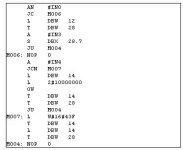Oring two values..???
- Thread starter Matchu04
- Start date
Similar Topics
I cannot find anything that says that Topserver or any OPC server stores values. (except in the simulator or the Historian plug in). My...
Hi.
So I finally got my HSC to work with the RA_HSCPlugin thanks to @PLC Pie Guy .
I'm using an AB 2080-LC20-20QWB with a 2080-MOT-HSC extension...
Hello,
During runtime I change values of some internal tags (i.e. F_CV of DO tags). And I want them to be saved when I switch runtime off, and...
hello. i am trying to store the values of a sensor every 1 minute to an array of 3. and compare the 3 values to see of the values is increasing or...
Hi guys.
Just upgraded to 5000. Still getting my head around 500 but due to an upgrade of hardware new software needed.
So after some...





